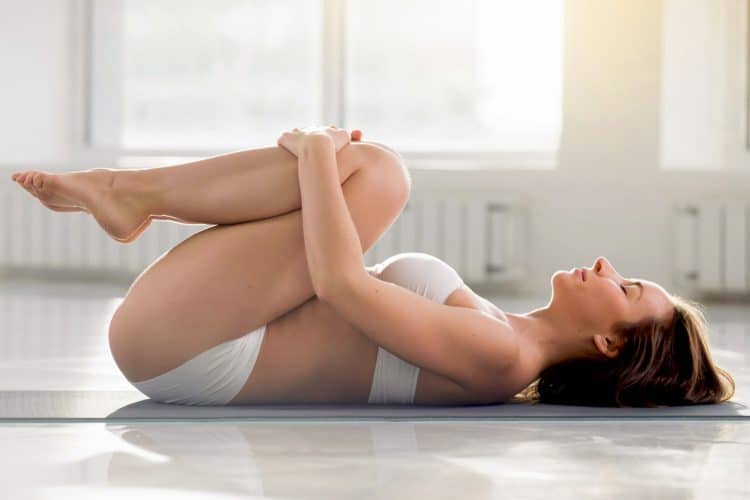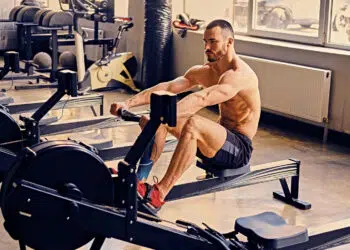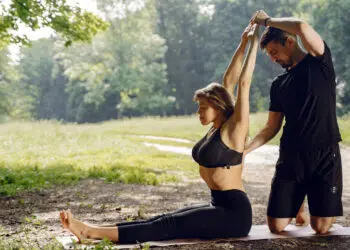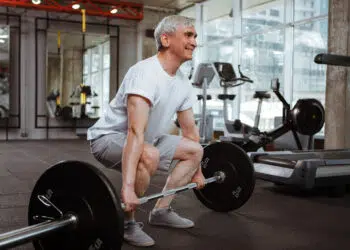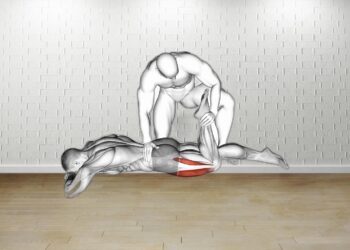Our bodies are made up of hundreds of muscles, although some are more prominent both in size and functionality such as the ones that make up our lower extremities like the hips, glutes, hamstrings, and lower back muscles. They help us to move around, perform various activities, and even maintain our balance and posture.
But just like a well-oiled machine, these muscles need to be maintained to ensure they last long and ensure we can use them optimally for many years.
“A lot of people don’t understand that stretching has to happen on a regular basis. It should be daily,” explained David Nolan, a physical therapist at Harvard-affiliated Massachusetts General Hospital.
In this guide, we’ve explained how to do a proper knee-to-chest stretch with video instruction. Plus learn about the benefits of stretching and check out some of the variations you can do too.
How To Do The Knee To Chest Stretch
Below we’ve included step-by-step instructions for the knee to stretch exercise.
- Lie on your back while keeping both knees bent and your feet flat on the floor. While optional, you can place a pillow or cushion under your head as shown in the video example.
- Grab the back of your thighs with hands just below the knees and pull them into your chest until you feel a good stretch in your glutes and lower back. You can also hold the top part of your knees if more comfortable.
- Hold the stretch position for about ten seconds, then relax your legs and repeat two more times.
Check out the video example below to see how it’s done.
Want to know how many calories you burn stretching? Use our calories burned stretching calculator here.
Level Up Your Fitness: Join our 💪 strong community in Fitness Volt Newsletter. Get daily inspiration, expert-backed workouts, nutrition tips, the latest in strength sports, and the support you need to reach your goals. Subscribe for free!
When To Perform The Knee To Chest Stretch
All too often we see people performing stretches first thing in the morning and/or before they engage in physical activity such as sports and weight training. Heck, we’re probably all guilty of doing this at some point. And while it may very well be fine for some, it may be better to stretch after the muscles are warmed up.
Cold muscles fibers are not necessarily as loose and pliable with less blood flow to the area and jumping right into intense activities could cause injuries. Therefore, we recommend doing a light activity or form of exercise before performing the knee to chest or any stretch.
Benefits
Let’s talk about the benefits of doing exercises like the knee to chest stretch.
Note: The knee to chest stretch or its alternatives should not be used as a replacement for proper medical treatment of serious and persistent lower back pain.
Loosen up
Stretching can help relieve muscle tension caused by sitting for extended periods or even overuse (performing tasks that involves repetitive involvement of the lower back).
Maintain mobility and flexibility
Much like a stiff neck, a stiff lower back limits range of motion and makes day to day activities a pain… literally! By maintaining the mobility and movement in the lower back you’ll prevent overstraining of the associated muscles.
May prevent injuries
When muscles are tense and tight, they do not function as optimally, and this could make you more prone to injuries. It limits range of motion and forces other muscles to compensate while also having an effect on the joints too. This is especially true of the lower body muscles.
Easy to do and requires little time
One of the best reasons to include this stretch for your lower back is because it’s very simple to do and you don’t need any exercise equipment or gear. Not to mention, you don’t need much time to stretch the lower body muscles.
Level Up Your Fitness: Join our 💪 strong community in Fitness Volt Newsletter. Get daily inspiration, expert-backed workouts, nutrition tips, the latest in strength sports, and the support you need to reach your goals. Subscribe for free!
Variations
The knee to chest stretch is a simple way to relieve lower back pain and tight glutes. However, there’s more than on option for stretching out these muscles. Check out these great variations.
Single knee to chest stretch
The most obvious variation is the single knee to chest stretch. Some may feel a better or more focused stretch with this version.
To do it:
- Lie on your back while keeping both knees bent and your feet flat on the floor. While optional, you can place a pillow under your head as shown in the video example.
- Grab the back of either thigh with both hands just below the knee and pull it into your chest until you feel a good stretch in your glutes and lower back.
- Hold the stretch position for about ten seconds, then relax your leg and repeat a few more times.
- Switch legs and repeat.
Related: Scorpion Stretch – Muscles Worked, How-To, Benefits, and Alternatives
Seated knee to chest stretch
Many of us have desk jobs that keep us on our butts for forty plus hours per week which can cause tightness and pain in the lower back. The great thing about the seated knee to chest stretch variation is that it can be done from your chair to alleviate discomfort.
To do it:
- Sit up straight with good posture then lift either knee up toward your chest.
- Grab onto either the front of the knee or the back of the leg just below the knee with both hands.
- Pull up on the leg until you feel a stretch in your glutes and lower back.
- Hold for ten seconds then relax the leg and repeat two more times.
Tips:
- Allow your body to relax as you perform the stretch.
- Avoid leaning forward but rather remain with an upright but relaxed posture.
- You do not have to pull your knees all the way up if it’s uncomfortable as long as you feel a stretch in the glutes and lower back.
- You can also grab the back of the hamstring if you feel pain in your knees.
- If you feel pinching near the hips, try to pull your knee slightly more outward.
Watch a demonstration and entire explanation with tips on the seated knee to chest stretch below.
Muscles Involved
The knee to chest stretch is not a muscle or strength-building exercise. However, stretching out the muscles of the lower body is good for preventing injuries and maintaining physical performance. Below we’ve included brief descriptions of the muscles involved in the knee to chest stretch.

Glutes
Knee to chest stretches are primarily glute focused. For the stretch to be effective, you should feel lengthening of the gluteus maximus muscle, the biggest muscle of the butt and the largest muscle in the body.
Anatomically, the gluteus maximus extends and externally rotates the thighs.
Lower back/erector spinae
A tight lower back can cause limited mobility and pain in the posterior chain (backside of the body). Knee to chest stretches can help to loosen up these muscles.
Hamstrings
Below the glutes on the back of the legs are the hamstrings muscles responsible for hip extension and knee flexion which is the opposite responsibility of the quadriceps. Hamstrings have three muscles – semitendinosus, semimembranosus, and biceps femoris (short head of biceps femoris only crosses the knee joint).
Heavily involved in sprinting and jumping, hamstrings are an explosive, athletic muscle that load up during the shortened positioned and launch us forward during leg extension.
Get Stretching!
It’s hard to debate the benefits of stretching on the body and mind and the lower back tends to be a place where we hold a lot of stress whether that’s due to sitting long hours, overuse, or injuries. And it’s good to know that almost anyone can utilize ad benefit from a simple lower back stretch and its variations.
Interested in measuring your progress? Check out our strength standards for Hip Extension, Leg Extension.

